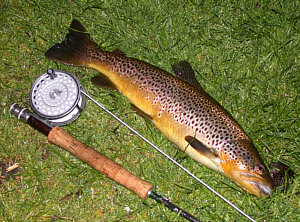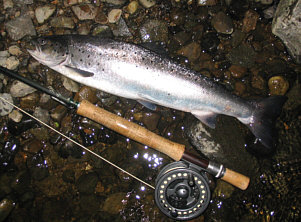Sea Trout
What is a Sea Trout?
|
The sea trout and the brown trout,
although appearing to be genetically identical, differ
greatly in habit and behaviour. They breed together, indeed
interbreed, in the same freshwater streams. Some trout,
which we know as brown trout (or Salmo trutta), spend
their whole lives in the freshwater streams of their
birth, while others, which we know as sea trout (or Salmo
trutta trutta), become anadromous, migrating to sea after
spending two or three years in freshwater, to grow on the
relatively rich marine feeding before returning to their
native rivers to spawn after a year or two at sea. The sea
trout, then, is a migratory brown trout. Why, then, should
some brown trout migrate while others do not? The answer
most probably lies essentially in the nature of their home
rivers and their varying capacity to support a trout
population. For a light hearted take on the pros and cons of
trout migration, see
Should I Stay or Should I Go?
|
 |
 |
|
Brown Trout |
Sea Trout |
Sea trout are to be found primarily
in the rivers and coastal waters of northern Europe, ranging
from as far south as Spain and Portugal, throughout northern
and western France, Great Britain and Ireland, the Baltic
and Scandinavian countries and as far north as Iceland. The
sea trout is one of our most precious game fish and is known
to anglers throughout the British Isles by various names,
e.g. as sewin in Wales, peal in the West Country, white
trout in Ireland, mort in North West England. The smaller
sea trout, returning to their home rivers in their first
year of migration, are known by various local names, such as
finnock, herling, whitling and smelt. Some of these early
returning sea trout may spawn but the majority of sea trout
spawn only after spending at least a full year at sea, when
they will generally have reached a weight in excess of one and a half
pounds. Sea trout size varies from river to river and from
one region to another. The Border Esk, for example, had
large runs of relatively small fish, averaging under two
pounds, while others, such as the Towy, Dovey and the
Northumbrian Tyne, to name but a few, are known for their
larger fish, many in double figures, these large sea trout
having made repeated annual spawning runs, migrating to sea
each winter after spawning to gain weight before returning
again to their home rivers the following summer.
On their return to freshwater, sea
trout, like salmon, generally cease to feed, subsisting on
reserves of energy stored up during months of rich sea
feeding. Yet they will, on occasion, take items of food, or
an angler's bait, whether through habit, aggression,
curiosity, playfulness
or whatever. The task of the angler is to figure out where
and when they may be persuaded to do so. He has found that,
except in conditions of high water, when sea trout may be
taken on fly, bait or spinner in much the same way as
salmon, his best chance of catching sea trout will be during
the hours of darkness, particularly shortly after dusk and
sometimes later, especially when the nights remain warm. The
sea trout, then, presents a unique sporting challenge,
drawing many of us to the river through the all-too-short
summer nights.
|
|